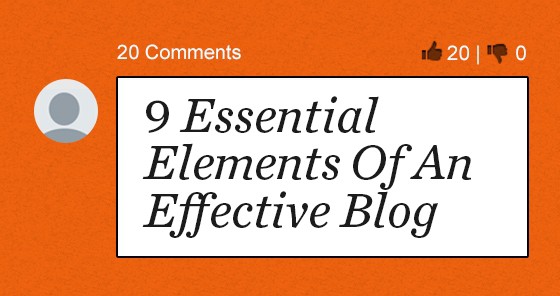So, you want to write the perfect blog post. A blog post that attracts clicks, likes, and shares. A blog post that gets read all the way through – and has a real effect on readers, whether that means driving conversions or establishing you as an industry thought leader.
Lucky for you, Zen Media is here to help! There are nine key elements that are essential to the crafting of an effective blog post. If you incorporate them all into your blog post, you’ll be well on your way to writing the perfect blog.
1. The Title
We know, we know, you’ve heard this one a thousand times before. But that’s because it’s so vitally important to any blog post’s success. It doesn’t matter how much time and effort you put into the writing of your blog post – if no one clicks on it because your headline is boring, you might as well not have written one at all.
Your blog title must be interesting. It doesn’t have to be funny or mysterious – of course, it sure helps if it is. But developing your title based on a few simple tips can make all the difference in the world.
For example, research has shown that including numbers in a title has the power to draw eyes and clicks. Explanations abound – some say it’s because numbers are more eye-catching than words. Others say that it’s because the reader knows exactly what to expect, timewise. (There will be 5 tips in this blog, no more, and no less – I’ve got time to read that!) Whatever the reason, numbers work – which is why list posts are so popular.
2. The Hook
Once you’ve persuaded people to click on your blog post, the next step is hooking their interest right from the first sentence. That first paragraph is all-important in determining whether readers will leave the page within seconds, or stick around to read the whole thing. You’ve got to have a hook.
What exactly constitutes a hook? Try a question – they draw people in because once a question has been posed, our natural response is to look for an answer. Another approach is to tell a story. Nothing grabs people’s attention more quickly and more thoroughly than a story. Experiment with various hooks to see what works best with your particular audience.
3. Visual Appeal
Reading the text on a screen is different from reading it on paper. There’s just something about the internet that has conditioned us to gravitate towards shorter blocks of text, and avoid long, dense ones, when online. Whereas a magazine article can have long paragraphs and complex sentences, blogs need to be visually broken up in some way, to create plenty of reassuring white space around and between the lines.
One way to accomplish this is to use bullet points. Numbered lists are also effective, as are subheaders. Short sentences and short paragraphs are necessary to keep readers’ attention. The ideal length for a blog post itself is a matter still under debate – some say shorter is better, as in 250 words or less, while others maintain that long, 1500 to 2000-word posts are more effective. 500-600 words is a common standard. But no matter how long the post, as long as it’s broken up into manageable chunks, it will look approachable to visitors.
4. Solid Writing
Sorry to break it to you, but your high school English teacher was right – good, solid writing skills really are important in the business world. Even if you have an awesome blog topic, and do everything else right, the instant your grammar falters or your style becomes awkward, you lose all credibility with your reader. Think about it – how many sites have you visited, only to suddenly become distrustful and leave, because their writing was simply unprofessional?
Informal, conversational writing is one thing – it’s fine to break conventions now and again for the sake of sounding real. But demonstrating a lack of basic English language skills makes people nervous – if you can’t even be trusted to write a sentence correctly, how professionally will you really handle their business?
5. Personality
Nobody likes to read boring writing. That’s why textbooks never make it to bestseller lists. People like to read content that has style and flair – content through which you can see the personality of the writer. They want to feel like they have a personal connection with the writer, like they know a little more about them after they’ve read their post. And you don’t get to know someone through a dry recitation of facts or advice.
Add your own personal style to your writing, whether that’s humor, emotion, or even just a conversational tone. Make your writing sounds like you. Don’t be afraid of sounding unprofessional – on the contrary, giving readers a glimpse into your real personality will go a long way towards establishing your credibility with them.
6. Keywords
Now here’s a more controversial subject. With Google’s constant algorithm changes, best practices change often in this area. But luckily, they seem to be changing for the better. The use of keywords in your blog post is necessary if you want people to be able to find you via search engines. But the days of stuffing your post full of the same two or three words or phrases over and over again is long gone – and in fact, was never the way keywords were meant to be used in the first place.
The key to keyword use today is to be natural. Write for humans, not for search engines. Do include four to eight keywords in your post, but only if and when they fit naturally in your content – never try to force one, and never repeat a keyword endlessly. That will only mark you as spammy in Google’s eyes. Keywords used in titles and subheaders are especially helpful, as Google sees those as more important. But here too, good writing comes first, and keywords come second.
7. Interlinking
Another controversial topic, interlinking is meant, at its heart, to provide the reader with a better experience on your site. We’ve all seen those blog posts where it seems like every other word or phrase is hyperlinked to another page – that is not what we want to emulate. Instead, a 500-word blog post should include only about 4-5 links to relevant content that will give readers a more in-depth look at a related topic. One link per every hundred words or so is a good rule of thumb.
But the real key here is relevancy. Link to something that is unrelated to the anchor text (the blog text you hyperlinked to the new page) and Google gets mad. On the other end of the spectrum, if you get too matchy-matchy, Google gets grumpy, too. Avoid “exact match” links as well, where your anchor text says “buy goldfish” and it’s linked to “yourwebsite.com/buy-goldfish.” Instead, try linking that page to “thinking of purchasing a goldfish?” or something similar.
8. The Image
Humans have always been visual creatures, but the internet has made us even more so. Think of your own experience. Links to blog posts that appear in your Facebook feed without an image just don’t draw the eye, do they? But add a large, vibrant image that catches your attention, and suddenly, you notice the post, and are exponentially more likely to click on it.
Web pages with images are more appealing to us, as well, and make us more likely to stick around to read what they have to say. Including a great image is vital to your blog’s success.
9. The Call To Action
Finally, the way to achieve results from your blog post – the call to action. You need to end your post with a request. Tell your readers what you’d like them to do next. Visit your Facebook page? Check out your sale? Set up an appointment? Share their thoughts in the comments section? They won’t do it unless you ask.
BONUS ELEMENT: Valuable Content
This may actually be the most important point of all. Sure, fluff pieces can be fun, but if you’re not providing your audience with valuable information, they won’t be back. Your blog is not the place to be salesy, or pushy, or braggy. It’s the place to share your expertise generously, build up your credibility, and gain a loyal following. Keep that in mind, and you’ll be golden!
By including these 9 + 1 essential elements in every blog post you write, you’ll be an effective blogger in no time! And if you need help crafting the perfect blog, just give us here at Zen Media a call! We’d be happy to help you out.




